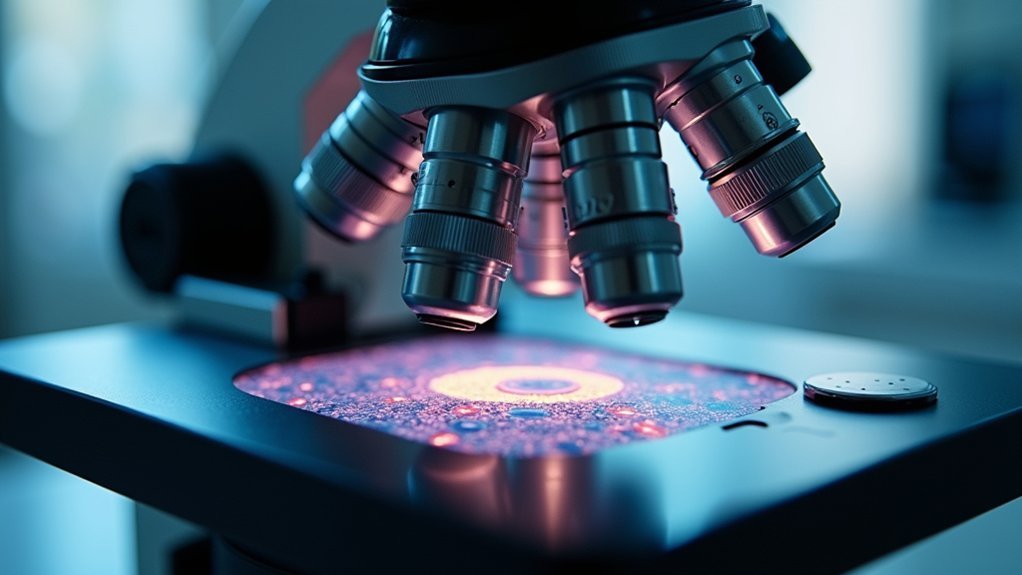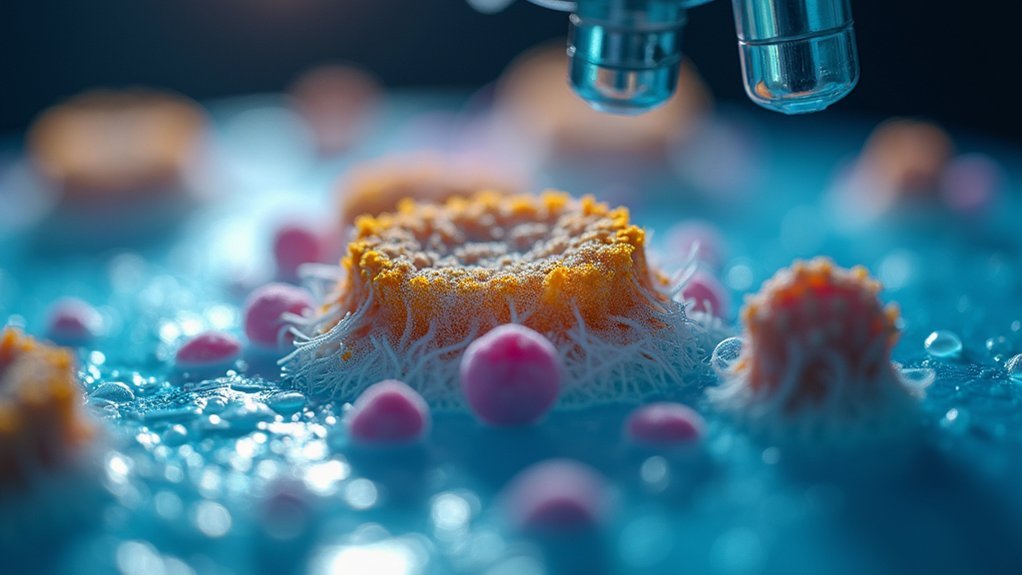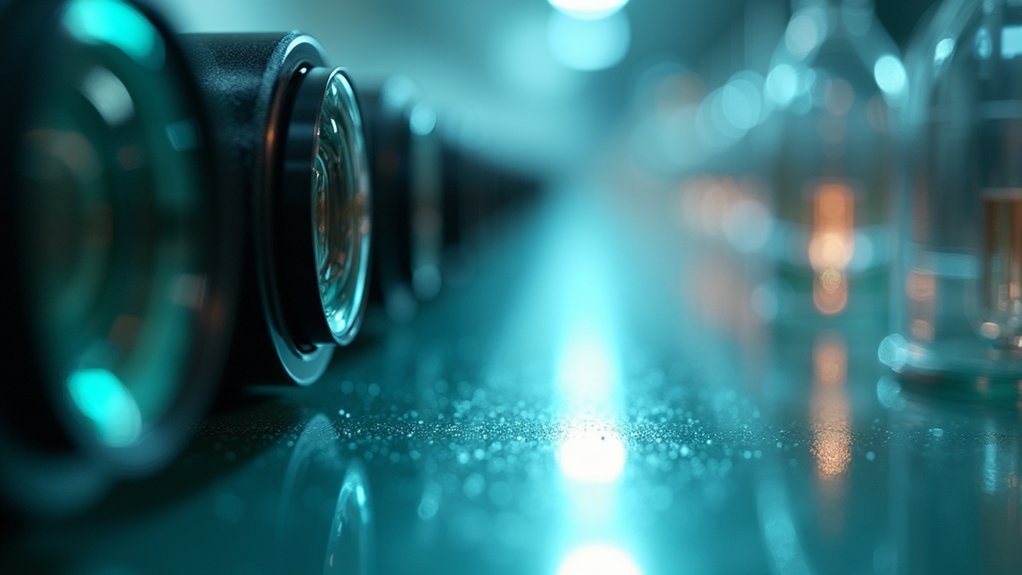To fine-tune focal planes for perfect scientific images, you’ll need systematic calibration using specialized software like MTFMapper. Test at approximately 30 times the focal length, capturing multiple shots while documenting all adjustments. Control environmental conditions, as temperature fluctuations can affect focus accuracy. Regular testing and meticulous record-keeping are essential for maintaining image sharpness over time. Understanding the mathematics behind focal plane relationships will transform your scientific imaging from acceptable to exceptional.
Numeric List of Second-Level Headings

Focus precision sits at the heart of scientific imaging excellence. When working with scientific imagery, you’ll need to organize your focus calibration workflow methodically.
Focus precision demands methodical calibration—the cornerstone of achieving exceptional scientific imaging results.
Consider these essential headings for your protocol:
- Initial Resolution Measurements
- Target Selection for Your Lens Focal Length
- Software Calibration Tools Setup
- Baseline Performance Documentation
- Adjustment Procedures
- Post-Calibration Testing
- Environmental Factors Monitoring
- Maintenance Schedule
Each step builds upon the previous one, creating a thorough system that’ll improve your images by up to 20% in resolution.
This is particularly critical when working with longer focal lengths where even minor focus errors can dramatically impact sharpness.
Understanding Focal Planes in Scientific Imaging
Precision of the focal plane determines the ultimate quality of scientific imagery. When you’re capturing microscopic details or distant celestial objects, even minimal focus errors can result in significant resolution loss, especially at longer focal lengths.
The focal plane is where light rays converge to form a sharp image, varying based on your lens’s focal length and subject distance. For best results, you’ll need proper focus calibration using specialized targets and analysis software to identify and correct any discrepancies.
Be aware that environmental factors like temperature can shift your focal plane, so it’s essential to calibrate in conditions similar to your shooting environment.
Don’t neglect regular recalibration of aging equipment, as physical wear and impacts gradually alter your lens’s focal characteristics over time.
Precise Calibration Techniques for Microscope Cameras

The five essential steps for microscope camera calibration begin with MTFMapper software implementation. This specialized tool analyzes focus accuracy and helps you adjust settings until your focus calibration achieves perfect alignment with intended targets.
You’ll need to regularly check back focus distances, as microscopic imaging is particularly sensitive to even minimal shifts that can dramatically impact resolution.
- Use various focus targets designed specifically for microscopic distances to avoid backfocus issues and guarantee accurate measurement.
- Conduct multiple test shots at different magnifications and apertures, as these variables can cause focus shifts in certain lenses.
- Maintain stability with heavy-duty tripods and proper illumination to enhance focusing precision.
Remember to document your calibration settings after achieving ideal focus—this reference point saves valuable time during future imaging sessions.
The Mathematics Behind Focal Plane Adjustments
You’ll need to understand the critical equations governing focal length relationships, expressed as f = (WD × AFOV)/sensor width, to properly adjust your optical systems.
Depth of field calculations provide the framework for determining acceptable focus ranges, with errors as small as an inch potentially affecting resolution by up to 20%.
Resolution optimization models, including the filter thickness compensation formula t(n-1)/n, allow you to make precise focal plane adjustments that maximize image clarity across varying working distances.
Focal Length Equations
Understanding focal length equations provides the foundation for mastering precise optical system adjustments in scientific imaging.
You’ll need to remember that focal length isn’t measured from the lens’s physical back but from its rear principal plane—a significant distinction for accurate calculations.
When you’re setting up your equipment, consider that shorter focal lengths deliver wider fields of view, vital for capturing thorough experimental scenes.
To calculate the angular field of view you’ll need, apply:
- AFOV = 2 × tan^{-1}(W / (2 × D)) where W is your desired view width and D is working distance
- Positive focal lengths converge light to your focal plane while negative values cause divergence
- Sensor size directly impacts your AFOV—larger sensors yield wider views with the same focal length
DOF Calculation Basics
When designing precise imaging systems, mastering depth of field (DOF) calculations becomes essential for controlling which elements remain sharp in your final image. The fundamental DOF equation, DOF = (2 × N × C × S²)/F², gives you precise control over your focal plane.
| Variable | Meaning | Effect on DOF |
|---|---|---|
| N | Aperture (f-number) | Larger N = Greater DOF |
| C | Circle of confusion | Sensor-specific constant |
| S | Subject distance | Greater S = Increased DOF |
| F | Focal length | Shorter F = Extended DOF |
| H | Hyperfocal distance | Key for maximizing focus range |
You’ll find that adjusting aperture settings provides the most immediate control over DOF. For scientific photography, calculating the hyperfocal distance (H = F²/(N×C) + F) helps you guarantee maximum sharpness from a specific distance to infinity.
Resolution Optimization Models
The mathematics behind enhancing resolution requires an extensive understanding of how focal planes interact with imaging parameters. You’ll need precise calculations connecting focal lengths, sensor dimensions, and working distances—where even an inch deviation can cause significant resolution loss.
When implementing focus calibration techniques, remember that MTFMapper software provides empirical data for fine-tuning your adjustments based on resolution measurements.
- Calculate Horizontal FOV = Vertical FOV × Aspect Ratio to determine ideal positioning
- Account for filter thickness and refractive index in back focus calculations
- Implement temperature compensation factors for environmental stability
Your focal lengths must be regularly recalibrated to maintain ideal resolution over time.
Optimizing Working Distance for Maximum Resolution
Although often overlooked by amateur photographers, working distance plays a critical role in achieving peak resolution with any lens system. You’ll achieve ideal results when setting your working distance to approximately 30 times the focal length, which minimizes focus errors and maximizes resolution quality.
When performing focus calibration, you must account for the lens’s specific back working distance. Don’t forget that filter thickness and refractive indices can shift your focal plane rearward, affecting your carefully calculated working distance.
For precise adjustments, consider using custom spacers or adapters to fine-tune your working distance. These small modifications can dramatically enhance image sharpness.
Common Focus Errors and Their Technical Solutions

Your camera’s focusing accuracy can drift over time, resulting in resolution penalties as high as 20% when back-focus or front-focus errors creep in.
You’ll need precise measurement tools like trapezoid targets and MTFMapper software to detect these calibration shifts, which often escape manual inspection methods.
Temperature changes and regular use may require adjusting your focus settings (for example, from -4 to -6 at 600mm), making consistent testing an essential part of maintaining ideal image sharpness.
Calibration Drift Analysis
While photographers often blame their technique for soft images, lens calibration drift remains a hidden culprit that gradually erodes image quality. Your lenses undergo subtle changes over time due to aging, temperature variations, and mechanical stress—all contributing to focus calibration errors that can greatly impact resolution.
At telephoto ranges like 600mm, even a small back-focus error of just an inch can devastate your image sharpness.
- Monitor your lens performance with precision targets and resolution measurements using tools like MTFMapper.
- Track calibration drift across different focal lengths—interpolation between settings can require specific adjustments (like Sigma’s shift from -10 to -9 at 400mm).
- Remember that environmental conditions affect stability—regular testing under your working conditions guarantees consistent performance.
Post-calibration improvements can yield up to 20% better resolution, making drift analysis an essential practice for maintaining optical excellence.
Back-Focus Measurement Techniques
Three essential techniques help photographers accurately diagnose back-focus errors that compromise image quality.
First, employ MTFMapper software with standardized focus targets to quantify the exact back-focus measurement discrepancy. This analysis reveals whether your images focus behind intended subjects—a critical issue at longer focal lengths where even slight misalignments cause noticeable sharpness loss.
Second, implement systematic calibration adjustments in small increments, testing results between each change. Most systems allow fine-tuning between -20 and +20, but ideal settings vary by lens and focal length.
Finally, establish a consistent testing protocol under controlled lighting and distance conditions. Regular focus accuracy checks prevent calibration drift, especially after equipment impacts or extended use periods.
This methodical approach guarantees your scientific imaging remains precisely focused regardless of shooting conditions.
Advanced Focus Stacking for Extended Depth of Field
When traditional depth of field limits your creative vision, advanced focus stacking offers a powerful solution. By capturing 10-20 images across different focal planes and merging them digitally, you’ll achieve extraordinary depth that’s impossible with single exposures.
Focus stacking transcends ordinary photography, unleashing unlimited depth through multi-frame capture where a single shot falls short.
For peak results, lock your exposure settings in manual mode to prevent artifacts in the final composite.
- Calculate your focus step size at approximately 1/3 of your current depth of field to guarantee seamless shifts between images.
- Maintain consistent camera position using a sturdy tripod and remote trigger to minimize alignment issues.
- Process your stack with specialized software like Helicon Focus or Adobe Photoshop for precise blending and alignment.
Remember to adjust your technique based on your subject’s complexity—more intricate specimens may require additional frames to capture complete focus throughout the scene.
Temperature Effects on Focal Plane Stability

Focus stacking delivers remarkable depth of field, but environmental factors can undermine your meticulously crafted images. Temperature fluctuations represent one of the most notable challenges to focal plane stability, as your lens materials expand or contract with changing conditions, shifting focus accuracy in subtle but image-degrading ways.
You’ll need to perform regular calibration checks, especially when shooting in environments with variable temperatures. Test your equipment in conditions that mimic your typical shooting scenarios to avoid unexpected focus shifts.
While some high-end lenses include temperature compensation features, don’t rely on these completely—they reduce but don’t eliminate the need for recalibration.
Monitor your lens performance consistently and be ready to recalibrate when temperatures change considerably. This proactive approach helps maintain focus precision and guarantees your scientific images remain sharp and accurate.
Hardware Modifications for Enhanced Focus Control
You’ll need precision spacers to make micro-adjustments to your optical system’s back focus distance, with high-quality options like Baader spacers allowing for incremental changes as small as 0.5mm.
When adding filters to your imaging train, be aware that each filter can shift your focal plane by varying amounts depending on its thickness and refractive properties.
Custom adapters from manufacturers like Preciseparts give you the ultimate control over these spacing adjustments, helping you achieve perfect focus regardless of your equipment combination.
Precision Spacer Selection
Three critical factors determine the success of your astrophotography focus: equipment compatibility, optical path length, and precise spacer selection.
When fine-tuning your focal plane, even sub-millimeter adjustments in spacer length can dramatically transform star shapes and image clarity. Custom adapters from manufacturers like Preciseparts offer tailored solutions for achieving ideal back focus with your specific optical configuration.
- Always account for filter thickness and refractive index, as these elements shift your focus point rearward and require compensatory adjustments.
- Consider adjustable options like Orion’s variable spacer (12-17mm) for situations where you need flexibility in your optical train.
- Verify back focus specifications directly with manufacturers to resolve potential discrepancies before purchasing spacers.
Don’t underestimate precision spacer selection—it’s often the overlooked key to transforming good astrophotography into exceptional scientific imagery.
Filter-Induced Focus Shifts
Building on our spacer selection discussion, let’s examine how filters fundamentally alter your optical train’s dynamics. When you add filters to your system, they create filter-induced focus shifts of approximately one-third the filter thickness (using the formula t(n-1)/n with glass refractive index ~1.5). This directly impacts your back focus distance.
| Filter Type | Thickness | Focus Shift | Required Adjustment |
|---|---|---|---|
| UV/IR Cut | 2mm | ~0.67mm | Custom spacer |
| ND Grad | 3mm | ~1.00mm | Recalibrate focus |
| Polarizer | 4mm | ~1.33mm | Adapter extension |
| Stacked | 6mm+ | ~2.00mm+ | Complete focus test |
Always test and recalibrate your setup after installing filters. Even a 1mm shift in a system with 50.17mm back focus can greatly impact image sharpness. Custom adapters offer precise compensation, ensuring ideal focus calibration despite these optical path changes.
Software Tools for Automated Focus Fine-Tuning

While manual focus adjustments might seem sufficient for casual photography, serious photographers often turn to specialized software tools that take the guesswork out of focus calibration.
Programs like MTFMapper analyze test images and generate color-coded results, allowing you to precisely evaluate focus accuracy across your entire focal plane.
Focus analysis tools transform technical calibration into visual insights, revealing the true performance of your optical system.
Many manufacturers, including Sigma and Tamron, offer lens calibration software that lets you fine-tune focus settings at various focal lengths.
You’ll achieve ideal results by pairing these tools with a properly printed focus target on stable materials.
- Use automated analysis software to detect subtle focus issues invisible to the naked eye
- Test with continuous autofocus enabled to simulate real-world shooting conditions
- Apply negative adjustments through calibration software to correct back-focus problems
Measuring and Documenting Focus Accuracy
To effectively measure focus accuracy, you’ll need specialized targets and systematic documentation practices that leave nothing to chance. Use trapezoidal focus targets and analyze them with MTFMapper to quantify focus alignment in precise resolution measurements (lp/mm).
Document all calibration adjustments meticulously, recording setting changes across focal lengths and distances. Even minor shifts can dramatically reduce image resolution.
Test consistently at approximately 30 times the focal length, which helps identify back-focusing issues. For reliable results, take multiple shots of your target, averaging the outcomes while simulating real-world conditions by de-focusing between shots.
Remember that environmental factors like temperature fluctuations can affect focus stability. Establish a regular documentation routine to track focus calibration changes over time, ensuring your scientific images maintain peak sharpness regardless of shooting conditions.
Frequently Asked Questions
How Do Chromatic Aberrations Affect Multi-Wavelength Imaging Focal Planes?
Chromatic aberrations cause different wavelengths to focus at different focal planes. You’ll need to adjust your focus for each wavelength when doing multi-wavelength imaging to guarantee all your spectral images are sharp.
Can Focal Planes Be Optimized for Living Specimens That Move?
Yes, you can optimize focal planes for moving specimens using autofocus systems, predictive tracking algorithms, or z-stacking with rapid acquisition. These techniques compensate for movement while maintaining focus on your dynamic living subjects during imaging.
What Vibration Isolation Systems Best Preserve Focus Accuracy?
You’ll get the best focus accuracy with pneumatic vibration isolation tables, active piezoelectric systems, or passive rubber/bungee cord setups. Don’t forget to take into account your specific microscope’s weight and sensitivity requirements.
How Do Vacuum Environments Alter Focal Plane Calculations?
In vacuum environments, you’ll need to recalculate focal planes due to the absence of air refraction. Your lenses will focus differently without atmospheric interference, requiring adjustments to compensate for the changed refractive index conditions.
Are Focal Plane Requirements Different for Polarized Light Microscopy?
Yes, focal plane requirements differ for polarized light microscopy. You’ll need to adjust for birefringent specimens that create multiple focal planes. Use the Becke line method and compensators for best focus of anisotropic materials.
In Summary
You’ve now explored how to fine-tune focal planes for scientific imaging excellence. By implementing proper calibration, understanding the mathematics, and utilizing both hardware and software solutions, you’ll capture sharper, more accurate images. Don’t underestimate temperature effects on stability, and always document your focus parameters. With these techniques, you’re well-equipped to produce the perfect scientific images your research deserves.





Leave a Reply